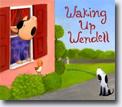 
|
Wendell lives on Fish Street. As on every other street where children live, birds sing, dogs bark, children play harmonicas, teakettles whistle and tires screech as working adults rush off to work. These are all part of the adventure of Waking Up Wendell . .
The birds singing to the rising sun wake old Mr. Krudwig, who gets up to walk his dog. The dog’s barking wakes up Mrs. Musky, who gets up and puts on her tea kettle. The teakettle awakens Mrs. Depolo, the kindergarten teacher, who is always late to class. Her screeching tires wake young Henry, who loves to play his harmonica before getting out of bed in the morning. This makes Henry’s mother very grumpy, and her shouting wakes the Darjeelings’ cat, who is sleeping on their kitchen doorstep.
The cat’s clawing on the screen door wakes all five of the Darjeeling children, and as the cat is let in and the screen door slams, Marjorie Parks awakes. Marjorie has been slumped over her sewing machine all night, trying to finish a wedding dress. The hum of the sewing machine will wake Mr. Wink, who will in turn call Lilah Hall and wake her. Lilah, who is wide awake now, begins singing in her shower. It is her beautiful singing that finally wakes up little Wendell.
Few picture books capture the imagination, whether the reader is five or fifty-five. The books about Miss Spider did that for this reviewer; the Christmas story by David McPhail that tells of the little boy who learned to read while helping Santa with his list is another. Waking Up Wendell is another that I will gladly add to my list. is another that I will gladly add to my list.
The watercolor-style illustrations using primary colors, as well as bright purple and orange, make this a beautiful book just to look at. The detail in the illustrations, such as the book titles by the bed of the Darjeeling family, the ABCs on the teacher’s coat, and the bird mobile over Wendell’s table make this an exceptionally well-done piece.
The illustrator takes great care to carry out the characters in the story. The boat you see in Leopold’s driveway at the beginning of the story is shown at the lake - with Leopold in it - at the end of the story. The mailboxes pictured several pages into the story each have the numbers of the houses on them, thus reinforcing the counting format.
This is the author’s first children’s book, although she has written adult titles. Her blend of a counting book with the use of colors and shapes on almost every page makes this a great teaching tool. This author/illustrator team has succeeded in developing a classic, and I hope to see many more children’s books of this caliber. This is well done.
|







|